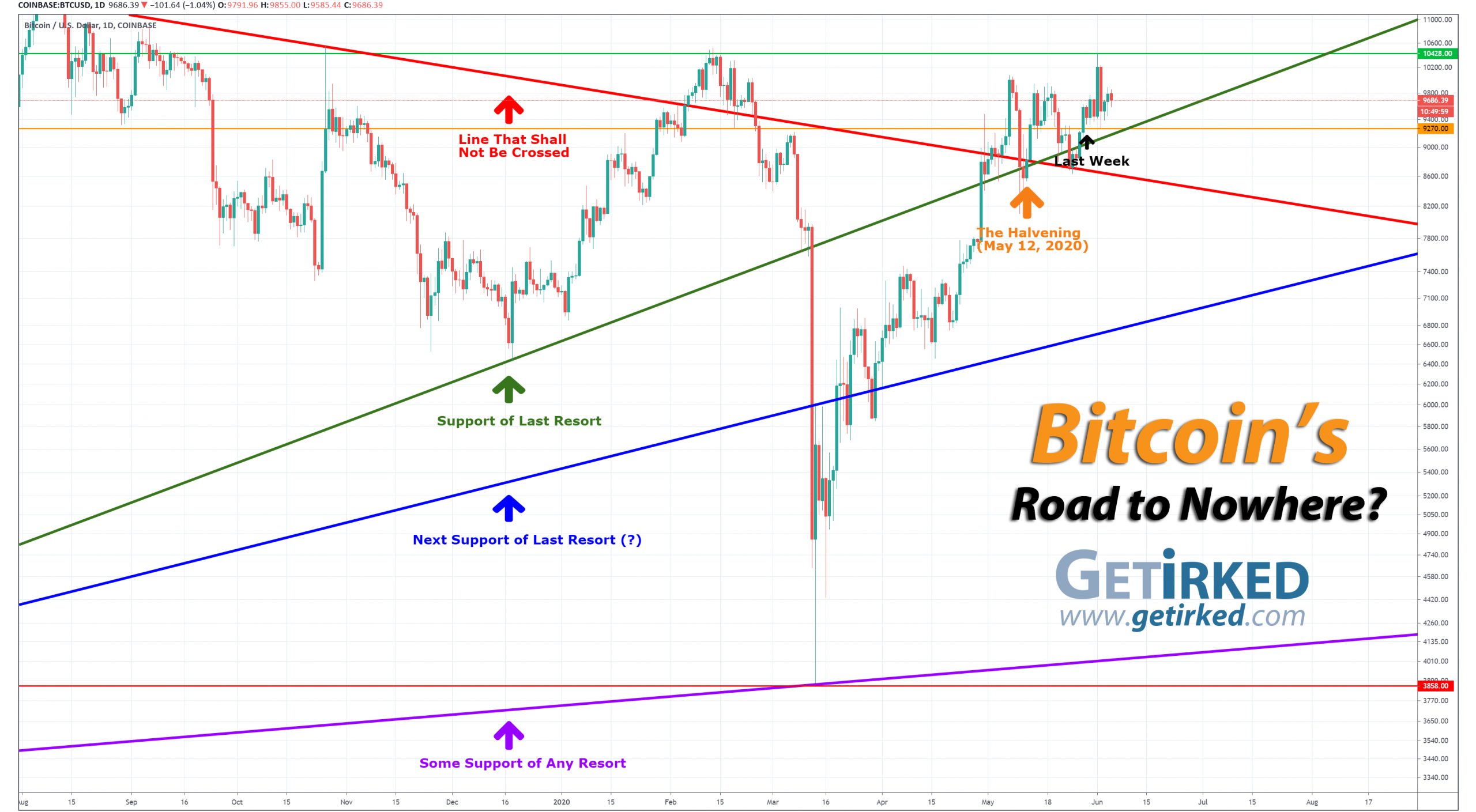Summing Up The Week
The country is in turmoil – civil unrest rages nationwide, unemployment is at near-Great Depression levels, and, oh yeah, there’s still an unbelievably deadly and extremely contagious virus running rampant throughout the globe.
So, what does the stock market do? It rallies triumphantly!
Do you want to know what the heck is going on?
Read on…
Market News
Civil Protests have No Effect on the Market
Many were puzzled when the market rallied on Monday and Tuesday despite the protests across the United States over the weekend. Historically, civil unrest has little to no impact on equity markets, reported CNBC on Tuesday.
“U.S. investors tend to exceptionalize these developments and not expect there will be much turmoil,” said Tina Fordham, head of global political strategy at Avonhurst. “Investors expect that, although this violence is alarming, that it will blow over and that the U.S. is a law and order country and things won’t get further out of control.”
Jim Cramer, of CNBC’s Mad Money, said the reason the stock market rallied after the weekend’s protests was due to it being blind to social justice. “At the end of the day, the market has no conscience,” he said. “Investors are simply trying to make money, and that’s why they’re crowding into the stay-at-home economy stocks.”
Private Payrolls Decline Less than Expected in May
ADP, the private payroll manager, released its report Wednesday showing private payrolls declined by 2.76 million in May, a much smaller drop than expected, reported CNBC. Economists had been expecting a decline of 8.75 million.
Mark Zandi, chief economist (I’m thinking he’s not the “chef economist” the CNBC article originally identified him as, although that could be an interesting job) at Moody’s Analytics said that May’s loss “is obviously an awful number, but not as catastrophic as expected.”
Naturally, the market rally continued Wednesday morning following this less-bad-than-feared news.
European Central Bank increases Pandemic Bond Buying
The European Central Bank (ECB) announced Thursday that it will keep its interest rates unchanged and increased its pandemic bond buying to 1.35 trillion euros in an effort to prop up the economy, reported CNBC.
The ECB also announced it would increase the timeframe of the bond-buying from the end of 2020 until June 2021 or until the bank believes the crisis is over.
This additional liquidty provided by the ECB, like the Federal Reserve Bank in the United States, adds another backstop to the market, reassuring investors that the system will not collapse. Expectations of this ECB announcement may have contributed to the market’s remarkable rally earlier in the week.
US Jobless Claims Total 1.877M vs. 1.775 Expected
The U.S. Department of Labor released its weekly jobless claims report revealing a total of 1.877 million new claims versus the 1.775 million expected by economists, reported CNBC on Thursday.
While the news was a negative surprise, the figure does represent a decline from last week’s numbers. Continuing claims, however, provide a clearer picture of Americans who are still unemployed and that figure totaled 21.5 million, a gain of 649,000 over last week also worse than expected.
May Unemployment 13.3% vs. 19.5% Expected – Rally!
After the Labor Department’s report showed a 13.3% unemployment rate for May versus the 19.5% expected, the markets rallied on Friday, reported CNBC.
Let’s be real for a second – 13.3% unemployment is horrendous. That’s quite nearly as bad as the 14% unemployment seen in the Great Depression.
So, why did the market rally?
Because the news was “Better Than Feared.”
A phrase coined by Jim Cramer of CNBC’s Mad Money fame to replace the original “Better Than Expected” adage, Cramer refers to Better Than Feared (or BTF) when a company or organization is expected to release bad news and the actual report, while still awful, is not as awful as what was expected.
The result is a rally in the stock (or in this case, the market) because investors had already “priced in” the really bad news and “simply bad news” is an upside surprise.
Next Week’s Gameplan
This is full-on Selling Season now.
Tons of FOMO money is flowing in from the sidelines causing stocks to reach unbelievably overvalued levels. Keep in mind, I’m not saying I’m selling everything. I’m never all-in or all-out of the markets.
However, the froth on this rally is becoming readily apparent, so I’m peeling off profits here and there on positions that have become wildly ahead of themselves.
This Week in Play
Stay tuned for this week’s episodes of my two portfolios Investments in Play and Speculation in Play coming online later this weekend!
Crytpo Corner
Important Disclaimer
Get Irked contributors are not professional advisers. Discussions of positions should not be taken as recommendations to buy or sell. All investments carry risk and all readers must accept their own risks. Get Irked recommends anyone interested in investing or trading any asset class consult with a professional investment adviser to determine if an investment idea is suitable to them and their investment goals.
Click chart for enlarged version
Bitcoin Price (in USD)
%
Weekly Change
Bitcoin Price Action
It was another of those weeks where if you didn’t look at the price action over the week and just checked in here, it would look like a pretty benign +2.80% weekly gain, right?
Not so much.
Bulls were elated on Monday when Bitcoin rocketed 8%+ to hit $10,428.00 in just a few hours, a new monthly high, only to have their hopes dashed when Bears shoved Bitcoin back down on Tuesday, dropping -8.25% in 15 minutes to $9270.00.
What does it all mean?
Well, some analysts said it was “traders just being traders” while others are decrying that it’s the end of Bitcoin.
The Bullish Case
Bulls point to the $9270.00 low as a positive sign, claiming that institutional buying in the cryptocurrency market will cause all-new highs from here once the fabled $10,000.00 mark is broken.
Bulls also point to the break of the $10,079.00 mark (the most recent monthly high) is the start of a higher-highs, higher-lows pattern on the longer-term charts, another positive sign for rallies.
The Bearish Case
Bears point out that, once again, Bitcoin is unable to hold above $10,000, suggesting that the entire market needs to sell off dramatically in order to build up enough momentum to break through that point and head higher.
Some Bears point to the dramatic selloff in March, claiming that the rapid decline was not correlated with the selloff in the stock markets, but rather indicates the entire crypto asset class is headed down with some suggesting a $1500-$2000 price target for Bitcoin.
Bitcoin Gameplan: +4.77% Gain, New Position
Current Allocation: 0.929%
Current Per-Coin Price: $9,595.10
Current Status: +0.951%
After Bitcoin broke through $10,000 on Monday and started to consolidate around the $10,100 mark, I used $10,037 as my stop-loss (a previous point of support on the 4-Hour charts).
Turns out that was a good move as Bitcoin lost all support on Tuesday and crashed through my stop-loss and my next buy target, effectively closing one position and opening a new one in 15 quick minutes.
My previous position closed with a minor +4.77% gain over a few weeks. Nothing great, but, any landing you can walk away from…
My new position opened when Bitcoin shot through the $9600 mark. I narrowly missed Bitcoin’s low as my second purchase price targeted $9260 and Bitcoin stopped just short at $9271, but the ferocity of the selloff was such that I have adjusted my buy targets as you can see below.
Bitcoin Buying Targets
Using Moving Averages and the $3858.00 monthly low as guides, here’s my plan of buying quantities and prices:
0.698% @ $8937
0.929% @ $8565
1.161% @ $8156
1.393% @ $7668
1.857% @ $6866
2.530% @ $5812
5.138% @ $5045
6.633% @ $4488
9.165% @ $4016
10.652% @ $3628
Bitcoin Selling Targets
For the moment, I have no upside selling targets, instead preferring to use stop-losses to lock in gains when Bitcoin begins price consolidation and then reopening the position at lower levels if the stop-loss is triggered.
Why the differing quantities at each level instead of a flat percentage?
Rather than buying an equal percentage, I change my buying quantity at each stage as a reflection of how likely Bitcoin could bottom and rebound from that stage. Rather than increasing my quantity on the way down, I’m used a fixed amount of money, so I’m basing how much I buy by how likely I think Bitcoin will drop to a certain level. In this case, I don’t think it’s likely Bitcoin will be able to break its $3128 low, so my quantities under that price point are less to account for the chances it will get to them.
No price target is unrealistic in the cryptocurrency space – Bullish or Bearish.
While traditional stock market investors and traders may think the price targets in the cryptocurrency space are outlandish due to the incredible spread (sometimes a drop of near -90% or a gain of up to +1000% or more), Bitcoin has demonstrated that, more than any speculative asset, its price is capable of doing anything.
Here are just a few recent price movements over the past couple of years:
- Bitcoin rose +2,707% from its January 2017 low of $734.64 to make an all-time high of $19,891.99 in December of the same year.
- Then, Bitcoin crashed nearly -85% from its high to a December 2018 low of $3128.89.
- In the first half of 2019, Bitcoin rebounded +343% from $3128.89 to $13,868.44.
- From June 2019, Bitcoin dropped -53.64% to a low of $6430.00 in December 2019.
- From December 2019’s low, Bitcoin rebounded +64% from $6430.00 to $10,522.51.
- In March 2020, Bitcoin dropped -63.33% to a low of $3858.00, mostly in 24 hours.
- From $3858.00, Bitcoin has rebounded +170.30% to $10,428.00 in June.
- Where will Bitcoin go from here? Truly, anything is possible…
What if Bitcoin’s headed to zero?
The only reason I speculate in the cryptocurrency space is I truly believe Bitcoin isn’t headed to zero.
I am prepared for that possibility, however, by knowing I could potentially lose all of the capital I’ve allocated to this speculative investment. Professional advisers recommend speculating with no more than 5% of an investor’s overall assets. Personally, I’ve allocated less than 2% of my assets to speculating in crypto.
I feel that anyone who doesn’t believe in the long-term viability of cryptocurrency would be better served not speculating in the space.
On a good day, this asset class isn’t suitable for those with weak stomachs. On volatile days, the sector can induce nausea in the most iron-willed speculator.
DISCLAIMER: Anyone considering speculating in the crypto sector should only do so with funds they are prepared to lose completely. All interested individuals should consult a professional financial adviser to see if speculation is right for them. No Get Irked contributor is a financial professional of any kind.
Get Irked in your Email?
We’re making a list and checking it twice! If there’s enough interest, we’ll start sending the Week in Review straight to your inbox!
Interested? Click here to sign up!
Ways to give back to GetIrked:
Send me a tip via Stripe! Thank you!
Get free money by signing up for an account with my referral link for Schwab
Sign up for Gemini and we each get $10
Click this referral link to get the Brave Browser
If you use Brave, you can also use the Tip function to tip me in Basic Attention Token (BAT).
Suicide Hotline – You Are Not Alone
Studies show that economic recessions cause an increase in suicide, especially when combined with thoughts of loneliness and anxiety.
If you or someone you know are having thoughts of suicide or self-harm, please contact the National Suicide Prevention Lifeline by visiting www.suicidepreventionlifeline.org or calling 1-800-273-TALK.
The hotline is open 24 hours a day, 7 days a week.


